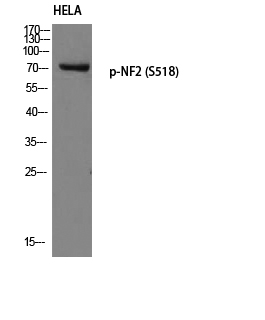Phospho Merlin (S518) Cell-Based Colorimetric ELISA Kit
- Catalog No.:KA1610C
- Applications:ELISA
- Reactivity:Human;Mouse;Rat
- Gene Name:
- NF2
- Human Gene Id:
- 4771
- Human Swiss Prot No:
- P35240
- Mouse Swiss Prot No:
- P46662
- Rat Swiss Prot No:
- Q63648
- Storage Stability:
- 2-8°C/6 months
- Other Name:
- Merlin (Moesin-ezrin-radixin-like protein) (Neurofibromin-2) (Schwannomerlin) (Schwannomin)
- Detection Method:
- Colorimetric
- Background:
- disease:Defects in NF2 are a cause of schwannomatosis [MIM:162091]; also called congenital cutaneous neurilemmomatosis. Schwannomas are benign tumors of the peripheral nerve sheath that usually occur singly in otherwise normal individuals. Multiple schwannomas in the same individual suggest an underlying tumor-predisposition syndrome. The most common such syndrome is NF2. The hallmark of NF2 is the development of bilateral vestibular-nerve schwannomas; but two-thirds or more of all NF2-affected individuals develop schwannomas in other locations, and dermal schwannomas may precede vestibular tumors in NF2-affected children. There have been several reports of individuals with multiple schwannomas who do not show evidence of vestibular schwannoma. Clinical report suggests that schwannomatosis is a clinical entity distinct from other forms of neurofibromatosis.,disease:Defects in NF2 are the cause of neurofibromatosis 2 (NF2) [MIM:101000]; also known as central neurofibromatosis. NF2 is a genetic disorder characterized by bilateral vestibular schwannomas (formerly called acoustic neuromas), schwannomas of other cranial and peripheral nerves, meningiomas, and ependymomas. It is inherited in an autosomal dominant fashion with full penetrance. Affected individuals generally develop symptoms of eighth-nerve dysfunction in early adulthood, including deafness and balance disorder. Although the tumors of NF2 are histologically benign, their anatomic location makes management difficult, and patients suffer great morbidity and mortality.,function:Probably acts as a membrane stabilizing protein. May inhibit PI3 kinase by binding to AGAP2 and impairing its stimulating activity.,similarity:Contains 1 FERM domain.,subcellular location:In a fibroblastic cell line, isoform 1 is found homogeneously distributed over the entire cell, with a particularly strong staining in ruffling membranes and filopodia.,subcellular location:In a fibroblastic cell line, isoform 10 is found homogeneously distributed over the entire cell, with a particularly strong staining in ruffling membranes and filopodia.,subcellular location:Observed in cytoplasmic granules concentrated in a perinuclear location. Isoform 7 is absent from ruffling membranes and filopodia.,subcellular location:Observed in cytoplasmic granules concentrated in a perinuclear location. Isoform 9 is absent from ruffling membranes and filopodia.,subunit:Interacts with SLC9A3R1, HGS and AGAP2. Interacts with LAYN (By similarity). Interacts with SGSM3.,tissue specificity:Widely expressed. Isoforms 1 and 3 are predominant, isoforms 4, 5 and 6 are expressed moderately, isoform 8 is found at low frequency. Isoforms 7, 9 and 10 are not expressed in adult tissues, with the exception of adult retina expressing isoform 10. Isoform 9 is faintly expressed in fetal brain, heart, lung, skeletal muscle and spleen. Fetal thymus expresses isoforms 1, 7, 9 and 10 at similar levels.,
- Function:
- formation of primary germ layer, mesoderm formation, regulation of protein amino acid phosphorylation, negative regulation of protein amino acid phosphorylation, regulation of cell-matrix adhesion, negative regulation of cell-matrix adhesion, regulation of DNA replication, negative regulation of protein kinase activity, cytoskeleton organization,negative regulation of cell adhesion, gastrulation, ectoderm development, mesoderm development, negative regulation of DNA replication, cell proliferation, negative regulation of cell proliferation, negative regulation of biosynthetic process, negative regulation of signal transduction, negative regulation of macromolecule biosynthetic process, negative regulation of phosphorus metabolic process, negative regulation of macromolecule metabolic process, regulation of protein kinase cascade, positive regulation of organelle organization, negative re
- Subcellular Location:
- [Isoform 1]: Cell projection, filopodium membrane; Peripheral membrane protein; Cytoplasmic side. Cell projection, ruffle membrane; Peripheral membrane protein; Cytoplasmic side. Nucleus. In a fibroblastic cell line, isoform 1 is found homogeneously distributed over the entire cell, with a particularly strong staining in ruffling membranes and filopodia. Colocalizes with MPP1 in non-myelin-forming Schwann cells. Binds with DCAF1 in the nucleus. The intramolecular association of the FERM domain with the C-terminal tail promotes nuclear accumulation. The unphosphorylated form accumulates predominantly in the nucleus while the phosphorylated form is largely confined to the non-nuclear fractions.; [Isoform 7]: Cytoplasm, perinuclear region. Cytoplasmic granule. Observed in cytoplasmic granules
- Expression:
- Widely expressed. Isoform 1 and isoform 3 are predominant. Isoform 4, isoform 5 and isoform 6 are expressed moderately. Isoform 8 is found at low frequency. Isoform 7, isoform 9 and isoform 10 are not expressed in adult tissues, with the exception of adult retina expressing isoform 10. Isoform 9 is faintly expressed in fetal brain, heart, lung, skeletal muscle and spleen. Fetal thymus expresses isoforms 1, 7, 9 and 10 at similar levels.
- June 19-2018
- WESTERN IMMUNOBLOTTING PROTOCOL
- June 19-2018
- IMMUNOHISTOCHEMISTRY-PARAFFIN PROTOCOL
- June 19-2018
- IMMUNOFLUORESCENCE PROTOCOL
- September 08-2020
- FLOW-CYTOMEYRT-PROTOCOL
- May 20-2022
- Cell-Based ELISA│解您多样本WB检测之困扰
- July 13-2018
- CELL-BASED-ELISA-PROTOCOL-FOR-ACETYL-PROTEIN
- July 13-2018
- CELL-BASED-ELISA-PROTOCOL-FOR-PHOSPHO-PROTEIN
- July 13-2018
- Antibody-FAQs

